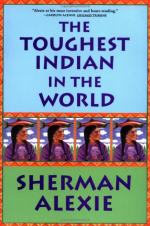|
This section contains 598 words (approx. 2 pages at 400 words per page) |

|
The Toughest Indian in the World Summary & Study Guide Description
The Toughest Indian in the World Summary & Study Guide includes comprehensive information and analysis to help you understand the book. This study guide contains the following sections:
This detailed literature summary also contains Quotes and a Free Quiz on The Toughest Indian in the World by Alexie, Sherman.
The following version of this book was used to create this study guide: Alexie, Sherman. The Toughest Indian in the World. Grove Press, 2000. First paperback edition.
The term “Indian” is used throughout this analysis in the same way as it is used throughout the book, i.e. as the common term for persons of Native American, indigenous ancestry.
Each of the nine short stories in this collection features a different protagonist, but almost all share a similar, and specific, cultural context. That context is defined by the particular beliefs and experiences associated with the American Indian community in and around Spokane, Washington, in the north-western region of the United States of America. Different aspects of those beliefs and experiences play significant roles in each of the stories, with considerations of life on “the rez,” or reservation, frequently being referenced. There are also a number of references to different kinds of “ceremony,” or ritualized aspects of American Indian life as they interact with the natural and / or spiritual world.
All that said, while each of the collection’s nine stories exists as its own narrative – that is, there are no groupings or sections in the book – there are certain thematic threads that reappear throughout a number of the stories, as different characters struggle with similar issues. For example, the female protagonist of “Assimilation” and the male protagonist in “Class” both struggle to define their ethno-cultural identity within the context of a mixed race marriage. A similar struggle over identity emerges in “Indian Country,” which dramatizes conversations and confrontations around a potential mixed-race marriage between two women.
Another narrative and thematic commonality shared by several stories is an exploration of relationships between men. “South by Southwest” and “One Good Man,” along with the collection’s title story, develop ideas and contemplations of this particular experience. Yet another commonality that appears in a couple of stories is a tendency towards narratives that contain a degree of fantastical. “The Sin Eaters” is one such story, as is “Dear John Wayne.” Finally, there is “Saint Junior,” which stands alone within the collection as the only one that might be defined as primarily a love story. Other stories in the collection consider aspects of different sorts of love relationships, but the heterosexual couple at the center of “Saint Junior,” both of whom come from American Indian backgrounds, are clearly and contentedly enacting a narrative defined by a shared experience of respectful love that has been earned and deepened over time.
Many of the stories in the collection share stylistic commonalities as well. All of the stories are written with a degree of poeticism in terms of imagery, structure, and language usage. “The Toughest Indian…” and “Indian Country” are arguably the least poetic, but they still contain a significant amount of metaphor-based language. On the other end of the continuum are stories like “One Good Man,” “Dear John Wayne,” and “The Sin Eaters,” in which the poetry of the language becomes potently evocative of the emotional intensity of the experiences through which the characters are living.
Another stylistic commonality between many of the stories is a narrative sensibility that evokes active relationships between past and present. Connections between what they have lived through in the past and how they are living in their current lives are particularly important in “Saint Junior,” “Dear John Wayne,” and “One Good Man.” This is in contrast to stories like “South by Southwest” and “Assimilation” are set more in the characters’ present, but still integrate a degree of consideration of important events in the characters’ pasts.
Read more from the Study Guide
|
This section contains 598 words (approx. 2 pages at 400 words per page) |

|



